By David Loveland
Fall 2020 Newsletter
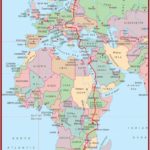 As I began reflecting on the completion, 25 years ago, of my bicycle journey from Cape Town, South Africa, to the North Cape of Norway, I felt the urge to reach out to those who helped me. The very first of those people was David Schweidenback, as he was the first person to not only help me but to believe that I could pull off this journey. I need to go back to 1992 to explain.
As I began reflecting on the completion, 25 years ago, of my bicycle journey from Cape Town, South Africa, to the North Cape of Norway, I felt the urge to reach out to those who helped me. The very first of those people was David Schweidenback, as he was the first person to not only help me but to believe that I could pull off this journey. I need to go back to 1992 to explain.
In July of that year, I arrived in Malawi as a Peace Corps Volunteer. Malawi is a small (less than 20 million people), landlocked, impoverished (perennially ranking in the bottom 5 in the world in terms of GDP) country in southeastern Africa. I was sent as a math teacher and was stationed in Namitambo, a remote village, with no running water or electricity, 5 miles from the nearest 2-lane, albeit dirt, road. In addition to teaching high school math, commerce, and world history to classes of 200+ students, I took on projects building teacher houses (one being my own) and installing wells to provide safe drinking water to the local villages.
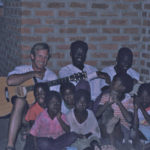
In such a remote setting, transportation, as my Malawian friends would say, was a problem. While there was a market in my village on Mondays, Thursdays, and Saturdays, where I could buy fresh tomatoes, cabbage, onions, and leafy vegetables as well as choose which part I wanted of the cow or goat slaughtered in front of me, nearly all other supplies could be bought only in the city of Blantyre, nearly 25 miles away. The typical routine for getting from Namitambo to Blantyre consisted of walking the 5 miles of foot paths and dirt tracks to the main road to wait for a bus, van, or other vehicle. Always crowded with people, diaperless babies, chickens, and the occasional goat, the buses and vans would slowly bounce their way along the rough road, stopping for passengers until not a single inch of space remained. From the door of my house to the bus station in Blantyre was, on average, a 2-hour ordeal. And the return trip was far worse, as I would have to carry whatever I bought the 5 miles home from the bus stop.
Not surprisingly, I was overjoyed when Peace Corps gave me a new mountain bike. It was cheap, with fragile components, but immediately became my primary mode of transportation. I could leave my house on the bicycle and be in Blantyre in a couple of hours. I attached a basket to the rear rack, made myself toe clips out of strips of old inner tubes, and became an expert at maintaining and repairing the temperamental machine.
One day, as I was riding home from a shopping trip to Blantyre, I entered that area of the road where pedestrian traffic far outnumbers vehicles. Bicycle bells constantly rang out to clear pedestrians from the middle of the road. I had no bell, so I relied on my voice, politely saying “zikomo” (literally “thank you” but also used to say “excuse me”) to warn walkers of my approach.
On this particular day, I was riding along, daydreaming of where I would like to travel when my two-year service ended. I approached an elderly Malawian man and called out my “zikomo” warning. This old man, dressed in his formal brown suit, turned his head slowly to see who was coming. His eyes popped open in disbelief when he saw me. He quickly regained his composure and his friendly, open face lit up the road with a smile.
“Ah, aaaaahhhh!” he exclaimed.
“Moni, abambo,” (hello, father) I said. “Muli bwanji?” (How are you?).
“Ah, aaaaahhhh!” he exhaled again. “I am fine. And how are you?”
“I am also fine, father”
“You speak Chichewa very well, my son,” he said, continuing in his native tongue.
“No. No. Only a little bit, father,” I replied.
He motioned for me to stop and we spoke for a few minutes. That short conversation changed the course of my life. It was nothing that either one of us said that convinced me that bicycling was the way for me to travel. It was the fact that we were having this conversation at all. It was because I was riding a bicycle and not driving a car or motorcycle that I met this wonderful old man.
“Yendani bwino,” (travel well) he said as I rode away.
Never before had those words, heard so often, meant so much to me.
Moving the pedals was now effortless. I was thrilled to be who I was, where I was. Everything around me took on a new light. The din of a scratchy record blaring out of a run-down bottle store mingled with the drunken sounds of friendship inside was beautiful, life-affirming music. The children waved to me with their hands, their smiles, and their shining eyes.
I decided then and there that the bicycle was the mode of transportation for me. When I finished my two years of Peace Corps service, I would get a bicycle and ride somewhere. Looking at my world map made choosing the somewhere easy. I was in southern Africa. I would start at the bottom of Africa and head north. I wanted to see the Middle East and Eastern Europe, so the top of Europe was also a logical choice. Besides, I am an engineer turned math teacher. From the bottom of one continent to the top of another made simple, symmetrical sense.
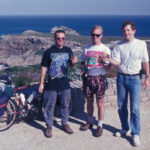
I wrote over a hundred letters from my little house in Namitambo, looking for sponsorship and support, and Dave Schweidenback was one of the few who answered. There were times when I thought he was more excited about my trip than I was, and his enthusiasm helped sustain my own. He worked tirelessly to help me in any way he could and was able to get me sponsorship where I failed. He convinced Bell Sports to donate a Trek bicycle and he provided bags, tools, and accessories for me to use. His many contacts provided me with support, comfort, and friendship along my route, as well.
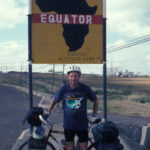
I left Cape Town, South Africa, on August 1, 1994. The route took me up the eastern side of Africa through Lesotho, Swaziland, Zimbabwe, Mozambique, Malawi, Tanzania, Kenya, Ethiopia, and Eritrea. As I had hoped, being on the bicycle exposed me to friendly people, wild animals, amazing food, and warm hospitality. The sights, sounds, and smells of everyday African life permeated and became part of my own.
With the Sudan/Egypt border closed, I took a ferry from Eritrea, across the Red Sea to Saudi Arabia. There, I was required to take a bus out of the country as they kind of frowned on blond foreigners cycling alone through their kingdom and I wasn’t too keen on the prospect of endless sand for hundreds of miles, myself.
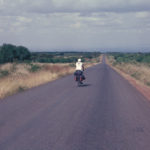
I was back in the saddle again from the Sinai Peninsula of Egypt, through Jordan (and the amazing Petra), and Israel. While it was peaceful and safe at the time, Syria was off limits to anyone coming from Israel, so I flew across the Mediterranean to southern Turkey, where I completed the Asian leg of my journey in Istanbul.
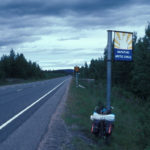
Crossing the Bosphorus into Europe, I headed north through Bulgaria, Romania, Hungary, Slovakia, and Poland, taking advantage of Peace Corps headquarters and volunteers along the way. Cruising through Lithuania, Latvia (where they only gave me a 48-hour visa), and Estonia brought me to the Baltic. Another ferry took me across to Finland where I started my final stretch to Norway, pushing myself to complete what I had started so long ago. I cycled all night, taking advantage of the 24-hours of daylight above the arctic circle in July, to reach the North Cape on the 365th day of my journey, July 31, 1995, logging over 150 miles in those 24 hours, and putting the finishing touches on nearly 12,000 miles in total.
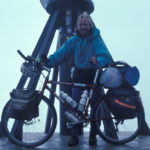
Thanks in large part to David Schweidenback and Pedals for Progress, that year changed my life forever. I have continued to cycle, riding the same bike around Iceland and the length of Viet Nam, as well as to work nearly every day while working in Malaysia, Brazil, and here in the U.S. Most importantly, my belief in humanity, in the kindness, warmth, and compassion of everyday people, no matter their race, religion, or nationality, was forever cast in stone.
